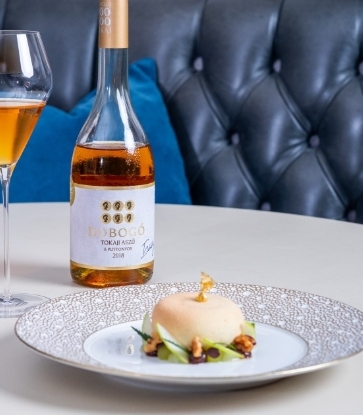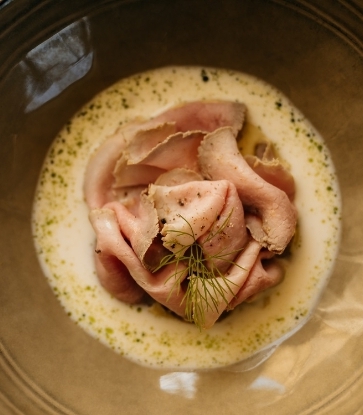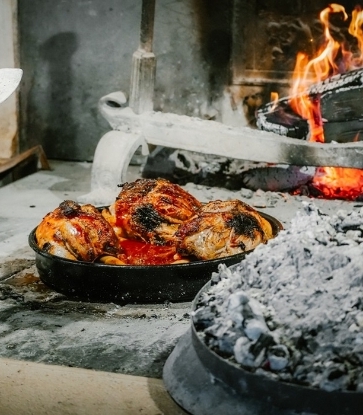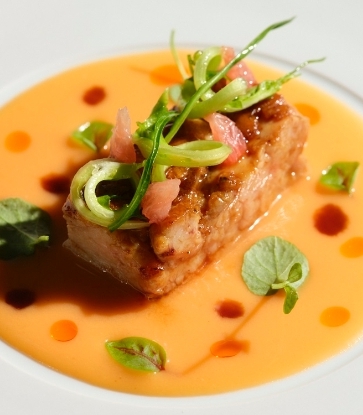Serbia isn’t just a perfect destination for visitors in search of culture and relaxation or for food-lovers. Thanks to the vast array of restaurants that continue to reinterpret its culinary traditions with a contemporary twist (such as Salon 1905), it’s also an excellent choice for lovers of wine in all its guises.
Vuk Vuletić is one of the best and most famous sommeliers in Serbia, whose awards include Best Sommelier of Serbia in 2017, Best Sommelier of the Balkans in 2018, and semi-finalist at the 19th edition of the ASI Best Sommelier of the World contest in Antwerp in 2019. Read his interesting profile below.
Born in Belgrade in 1991, Vuletić studied gastronomy at the University of Novi Sad, after which he gained experience working front of house in restaurants in Serbia, Germany and Italy. He soon realized that his true passion was for wine and cocktails and he hasn’t looked back since. Today, he is one of the most renowned international experts in Serbian, French and Italian wines (among others), as well as being one of the founding partners of the recently opened Pinot restaurant in Belgrade where, it goes without saying, he offers an interesting choice of wines by the glass.
“The Serbian wine scene has been on the rise for the past decade, and what we are witnessing is quite incredible,” explains Vuk Vuletić. “From the time I started working as a sommelier eight years ago in Belgrade to the present day, there has been a tremendous change in restaurant wine lists, in guests’ wine-ordering habits and general wine consumption; and, of course, local wineries have followed these trends. Nowadays, we have a much better understanding of our terroir and wine opportunities, so we can now state that the best terroirs would be Fruška Gora for Chardonnay and Grašac, Šumadija for Sauvignon Blanc, Negotinska Krajina for Cabernet Sauvignon, and the Župa & Toplički region for Prokupac. We have seen the emergence of small wineries producing high-quality wines where they have concentrated on just one or two grape varieties in their vineyards. Nowadays, there are more and more single-vineyard wines which demonstrate to us in different vertical tastings the significance of a particular vintage and the potential for aging and developing these wines. Most of Serbia’s wineries are quite young and have existed for less than 10 years, but what is certain is that they are making better wines from one year to the next as they gain experience and the vines in their vineyards age, resulting in better-quality grapes”.
But which Serbian wines should definitely feature in every wine cellar? Here is a list of sommelier Vuk Vuletić’s “must haves” in each category.

Sparkling: Kovačević Brut 2010 (Irig, Fruška Gora)
This Blanc de Blancs sparkling wine is made of Chardonnay with a hint of Riesling and is produced according to the méthode traditionnelle. In 2010, a large quantity of sparkling wine was produced, allowing the winery to release a few thousand bottles of the same wine each year but with a new disgorgement date. This enables wine-lovers to drink a vintage sparkling wine in 2022 that was aged for a full 11 years on the lees, and for the wine to gain its autolytic character of hazelnut and croissant, with fresh apple and pear aromas, bright acidity, but still round and generous on the palate and with a lovely finish.
The best part is that it sells for just a little bit more than your usual Prosecco, which makes it one of the best-value-for-money sparkling wines on the market. It is a good aperitif (as most sparkling wines are), but you can also combine it with a young creamy cheese (such as the Serbian kajmak), or even bruschetta with cheese, pear and hazelnut, which is now being served and paired on the menu in the Kovačević winery’s restaurant. Although purchases of Serbian sparkling are not particularly high at present, we are seeing an increase in both sales and consumption, and the most famous winery in Fruška Gora is moving on to a new 2011 vintage.
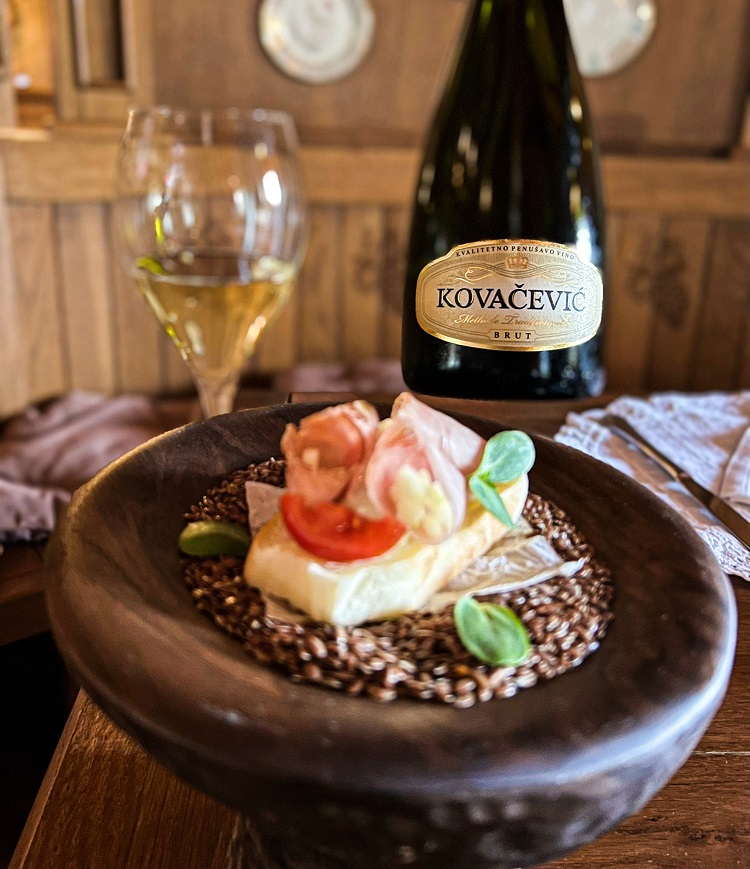
White: Vinum Grašac 2021 (Sremski Karlovci, Fruška Gora)
Italian Riesling, Welschriesling, Banatski Rizling and Grašac are all synonyms for one of the most widely planted grape varieties in Serbia. Nowadays, Grašac is accepted as the most appropriate name for this variety, and it is mostly grown in the Fruška Gora region, but you can also find it in Banat and Župa. This wine is usually drunk young, with a new vintage entering the market in early March, and it is usually sold within a year. The best wines are being made from the SK-54 clone, which features aromas of green apples, citrus and walnuts, and sometimes even a hint of kiwi, with crispy acidity and a light to medium body. It can be easily enjoyed without food, but for me the best pairings are with fish from the Danube, making it something of a geographical pairing.
My favourite pairing is with grilled zander fish in one of the restaurants along the Danube. Zander has a delicate yet strong flavour and has a low fat content which enables it to match Grašac in both structure and aromatic intensity. Vinum is one of the best wineries for Grašac, but there are many more. And, nowadays, this characterful grape even has its own competition (Grow du Monde). The current vintage on the market is 2021, but a tasting of some older vintages from both the Vinum and Kiš wineries proves that although they are made for early drinking, they can easily age for 10 years, during which time they acquire a delightful honey and herbal character.

Red: Ivanović Prokupac 2019 (Aleksandrovac, Župa, Tri Morave Region)
Prokupac is the most important native grape variety in Serbia and is mostly grown in the Župa and Toplički region, but there is also an increasing number of newly planted Prokupac vineyards in Šumadija. This late-ripening grape is famous for its red fruit character, spicy pepper aromas, and herbal notes of dill. The Ivanović winery is, without doubt, one of the pioneers in the production of high-quality Prokupac wines and their benchmark 2019 Prokupac vintage represents great value for money. What I always admire in Ivanović’s Prokupac is its strong and firm tannin level, which makes it great for food pairings. Prokupac can be paired with a variety of dishes, but my favourite is with a slightly seasoned Serbian ćevapi, made from minced beef, and served with an ajvar sauce. You can find ćevapi in many restaurants, most of which have their own unique recipe for this famous traditional dish. What makes it a perfect pairing is the similar spiciness found in both the wine and the recipe, along with strong tannins that melt with the juicy proteins from the beef.
In Serbia, we also tend to eat a lot of pork, and Prokupac is a perfect pairing with this type of meat as it absorbs the fat from the pork. If this is accompanied by a plum sauce, Prokupac is able to match similar fruit aromas in the dish, in so doing enhancing the overall experience. Prokupac ages gracefully, gaining earthy and dried herb aromas as it does so, and some sample tastings have shown that even 20+ years of aging potential is achievable. Prokupac has its own day dedicated to it in the annual calendar (14th October), when the grape is celebrated in every restaurant. And starting this year, the Prokupac grape even has its own signature Riedel wine glass.

Sweet: Budimir Slatka Mala Tamjanika 2019 (Aleksandrovac, Župa)
Tamjanika is a variety of Muscat Blanc à Petits Grains and is widely planted in Serbia, mostly producing aromatic dry white wines with an attractive nose of elderflower. Budimir is one of the rare wineries that produces sweet wine from the Tamjanika grape, with its high sugar level, apricot and honey aromas, and lovely floral characteristics. It is best paired with a dessert such as Crepes Suzette, where the sweetness level in both the wine and food complements both, and where the characteristics of the fruit in each are similar and compatible. I personally prefer this sweet raisin wine made from Tamjanika grapes, as it can also act as a delicious dessert on its own. It is for this reason that many new producers are now making this style of wine, and there are even some who are producing some quite interesting sparkling wines with the same grape.

Hero image : Salon 1905 - Dish



